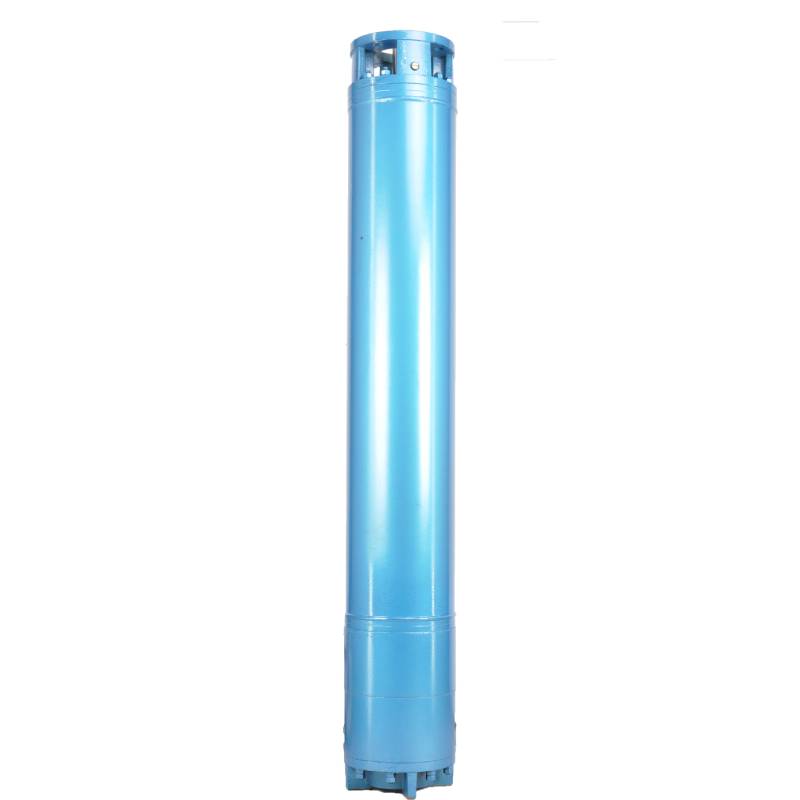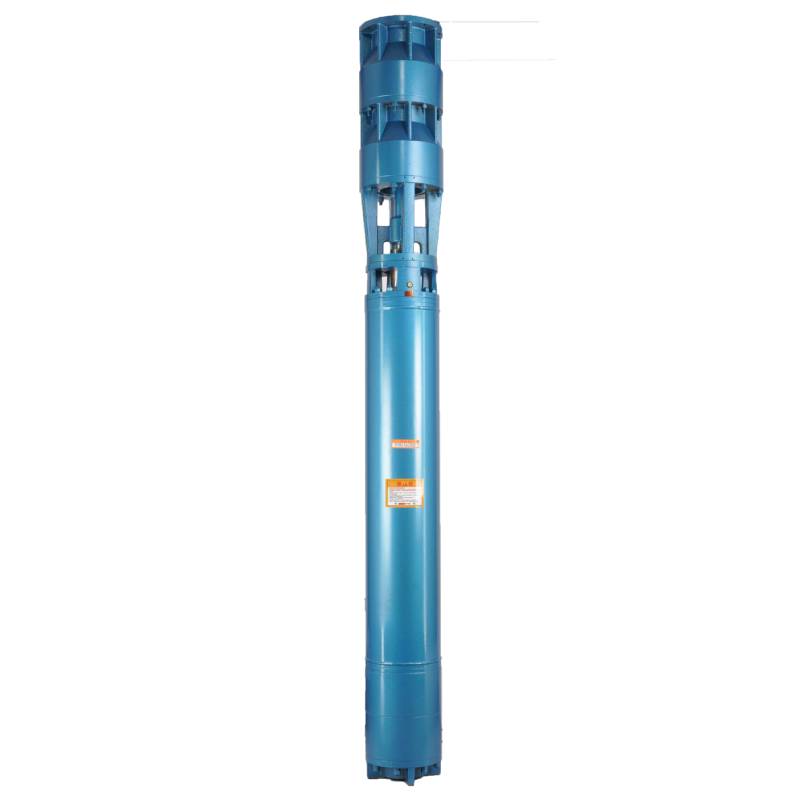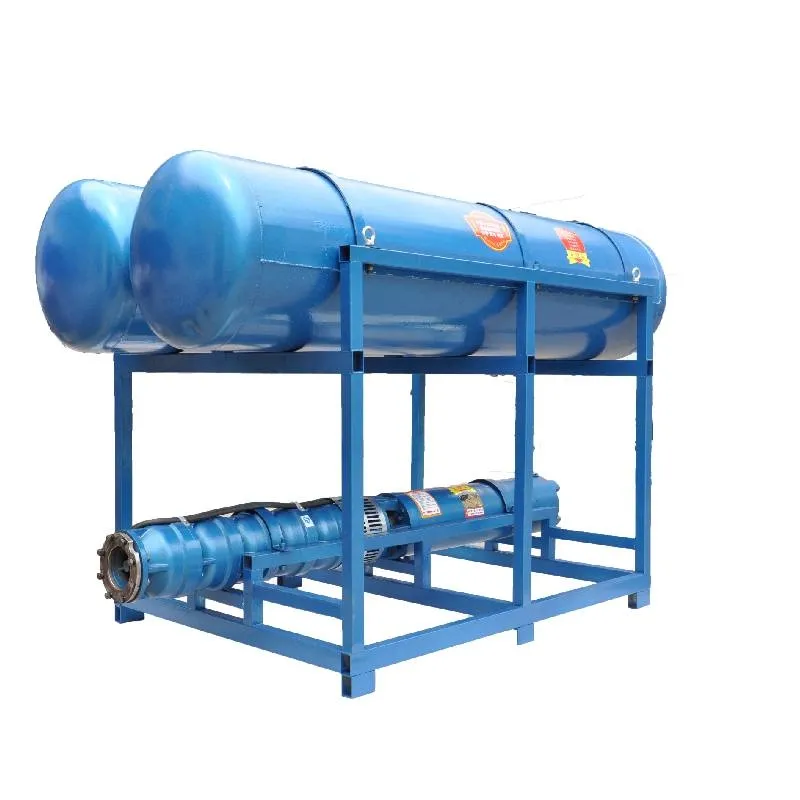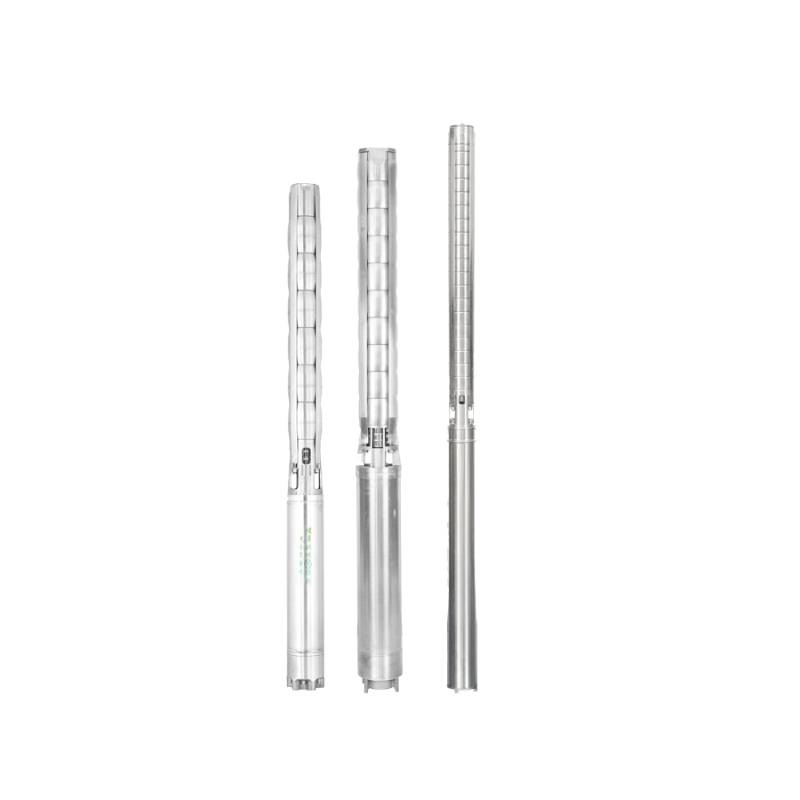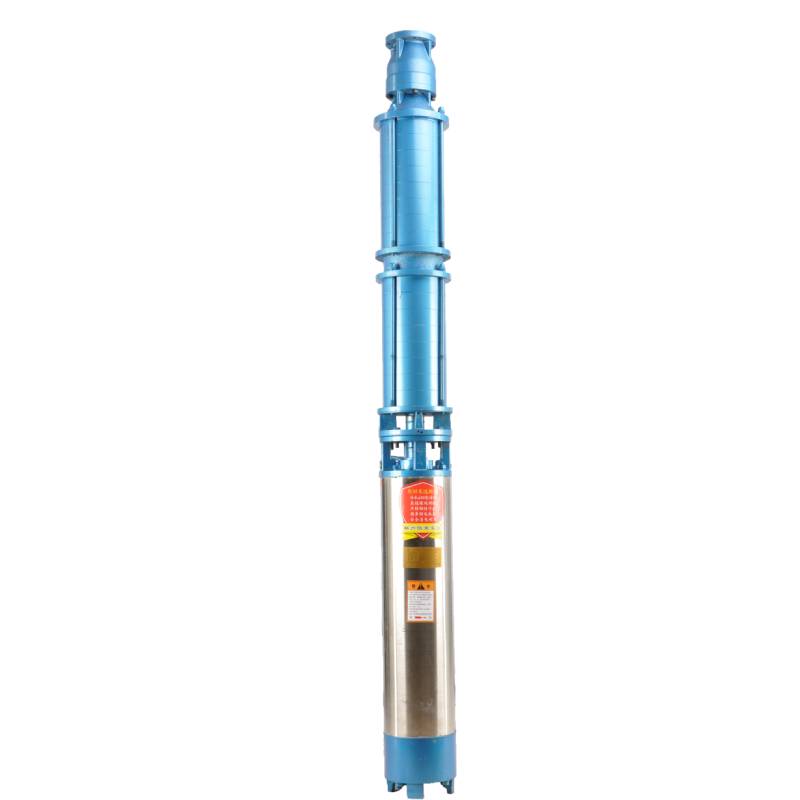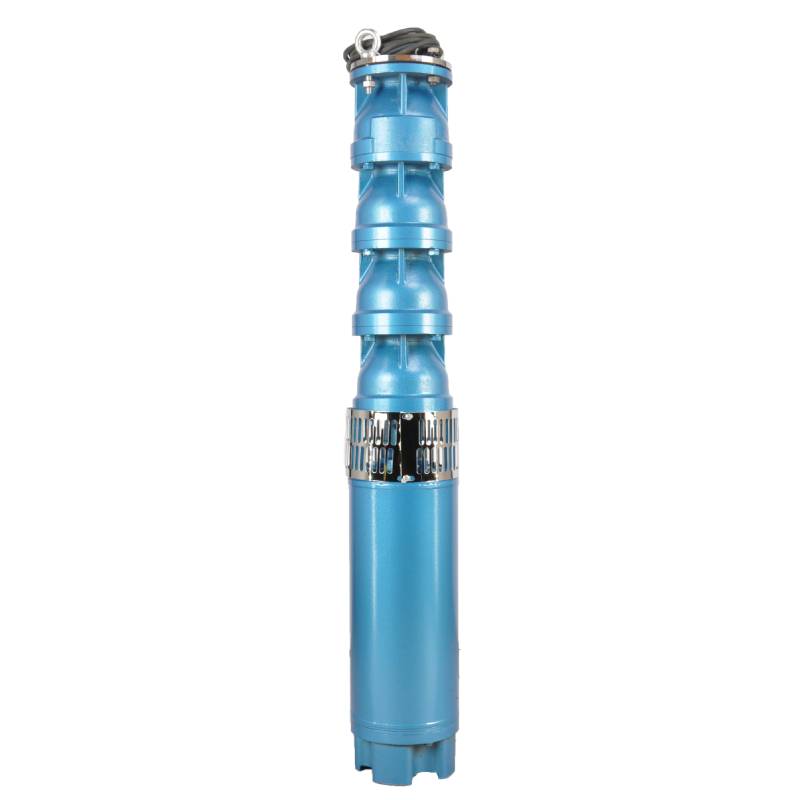This hot water pump adopts the motor made of 50W400 grade high quality cold rolled silicon steel, which is stamped by high speed punch press. It has the advantages of low stator iron loss and low self-heating. The motor winding is designed for hot water pump, high temperature resistance and anti-aging. The winding has water resistance, and adopts 3CR13 stainless steel blade shaft, high temperature resistant bushing and other high quality accessories to enable it to operate for a long time at high temperature, and can be used with frequency converter, so as to automatically adjust according to the amount of water used. This hot water pump is the ideal choice for your hot water equipment, which can operate stably and efficiently, providing you with a lasting hot water supply.
The product is a three-phase AC 380V (tolerance + / - 5%), 50HZ (tolerance + / - 1%) power supply submersible pump. With water quality requirements: water temperature is not higher than 20 °C; solid impurities content (mass ratio) is not more than 0.01%; PH value (pH) is 6.5-8.5; hydrogen sulfide content is not more than 1.5mg/L; chloride ion content is not more than 400mg/L. The electric pump adopts closed or water sealed wet structure, before use must be submersible motor inner cavity filled with clean water to prevent empty, and then tighten the water and air bolts, otherwise not to use. Its work should be completely immersed in water, immersion depth is not more than 70 meters, the distance between the bottom of the pump and the bottom of the well is not less than 3 meters. Well water inflow quantity should be able to meet the electric pump water output and continuous operation, the output water quantity should be controlled at 0.7-1.2 times of the rated flow. The well should be vertical, the electric pump can not be used horizontally or inclined, only vertically placed. The electric pump must be equipped with cables and external overload protection device as required. It is strictly prohibited to conduct no-load test under no water condition.
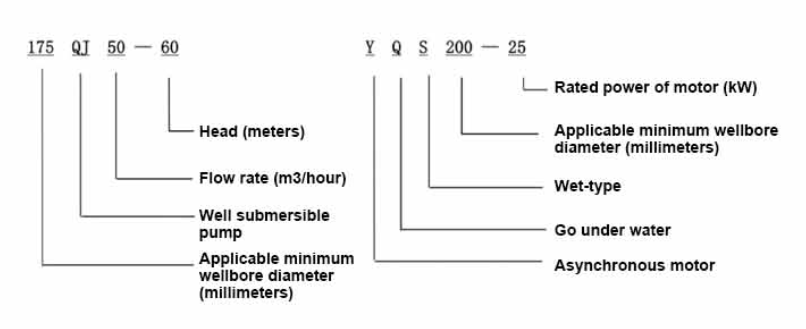
| Modelo | Caudal (m3/h) | Cabeza (m) |
Velocidade de rotación (cambio/punto) |
Bomba de auga (%) | Outlet diámetro (mm) |
Aplicable ben diámetro (mm) |
Calificado power(KW) |
Calificado tensión (V) |
Calificado corrente (A) |
Eficiencia do motor (%) | power factorcosφ | Unidade Tamaño máximo radial (mm) |
Observación | |||||||||
| 300QJ200-40 | 200 | 40 | 2900 | 76 | 150 | 300arriba | 37 | 380 | 77.8 | 85.0 | 0.85 | 281 | ||||||||||
| 300QJ200-60 | 60 | 55 | 115 | 85.5 | 0.85 | |||||||||||||||||
| 300QJ200-80 | 80 | 75 | 154.1 | 86.0 | 0.86 | |||||||||||||||||
| 300QJ200-100 | 100 | 90 | 183.8 | 86.5 | 0.86 | |||||||||||||||||
| 300QJ200-120 | 120 | 100 | 204.3 | 86.5 | 0.86 | |||||||||||||||||
| 300QJ200-140 | 140 | 125 | 249.5 | 87.5 | 0.87 | |||||||||||||||||
| 300QJ200-160 | 160 | 140 | 277.8 | 88.0 | 0.87 | |||||||||||||||||
| 300QJ200-180 | 180 | 160 | 317.5 | 88.0 | 0.87 | |||||||||||||||||
| 300QJ200-200 | 200 | 185 | 367.2 | 88.0 | 0.87 | |||||||||||||||||
| 300QJ200-240 | 240 | 220 | 436.6 | 88.0 | 0.87 | |||||||||||||||||
| 300QJ320-30 | 320 | 30 | 2900 | 77 | 200 | 300arriba | 45 | 380 | 94.6 | 85.0 | 0.85 | 281 | ||||||||||
| 300QJ320-60 | 60 | 90 | 183.8 | 86.5 | 0.86 | |||||||||||||||||
| 300QJ320-90 | 90 | 125 | 249.5 | 87.5 | 0.87 | |||||||||||||||||
| 300QJ320-120 | 120 | 160 | 317.5 | 88.0 | 0.87 | |||||||||||||||||
1, well submersible pump for clean water pump, prohibit the new well, pumping sediment and muddy water,
2, well water pump voltage grade of 380/50HZ, the use of other voltage grades of submersible motors need to be customized. The underground cable must use waterproof cable, must be equipped with starting equipment, such as distribution box, start not ready should have commonly used motor comprehensive protection function, such as short circuit overload protection, phase protection, undervoltage protection, grounding protection, idling protection, in case of abnormal conditions, the protection device should be timely action trip.
3, the installation and use of the pump must be reliably grounded, prohibit the push and pull switch when the hands and feet are wet, the installation and maintenance of the pump must be cut off the power supply, the use of the pump place to set up "to prevent electric shock" obvious signs:
4, down the well or before installation, the motor cavity must be filled with distilled water or non-corrosive clean cold boiling water, tighten the / water bolt, the pump on the ground test run, must be to the pump chamber water lubrication rubber bearings, instant start not more than a second, see whether the steering is the same as the steering instructions. When the pump is upright, pay attention to safety, prevent overturning injury.
5, estrictamente de acordo coas disposicións do elevador da bomba, o intervalo de uso de fluxo, para evitar a forza de bombeo de baixo fluxo ou alta elevación, o rolamento de empuxe e outras partes do desgaste, a sobrecarga do motor queimado
6, despois de bombear o pozo, a medición do motor á resistencia de illamento do chan non debe ser inferior a 100 M, despois do inicio para observar a tensión e a corrente, verifique o illamento do enrolamento do motor, se estea de acordo cos requisitos; A temperatura do lugar de almacenamento da bomba é inferior ao punto de conxelación, debe secar a auga na cavidade do motor, evitar que o dano do xeo da auga da cavidade do motor sexa causado pola baixa temperatura.
The pump part is mainly composed of pump shaft, impeller, shunt shell, rubber bearing, check valve body (optional) and other components. The motor part is mainly composed of base, pressure regulating diaphragm, thrust bearing, thrust plate, lower guide bearing seat, stator, rotor, upper guide bearing seat, sand discharging ring, water inlet section, lead cable and other components. The main characteristic of this product is that the motor is a water-cooled submersible three-phase asynchronous motor, and the motor cavity is filled with water to cool the motor and lubricate the bearing. The pressure regulating diaphragm at the bottom is used to adjust the expansion-contraction pressure difference in the body caused by the change of the temperature rise of the motor. In order to prevent the sand particles in the well water from entering the motor, two oil seals are installed at the upper end of the motor shaft extension, and a sand discharging ring is installed to form a sand discharging structure. In order to prevent the pump shaft from jumping when starting, the pump shaft and the motor shaft are connected together through a coupling, and a thrust bearing is installed at the bottom of the motor. The lubrication of the motor and the pump bearing is realized through water lubrication. The stator winding of the motor is made of high-quality well motor winding wire, with high insulation performance. The pump is designed by computer CAD, with simple structure and good technical performance.

(1) Preparación antes da instalación:
1. Comprobe se a bomba sumerxible cumpre as condicións de uso e o alcance especificados no manual.
2. Usando un obxecto pesado cun diámetro igual ao diámetro exterior máximo da bomba sumerxible, medir se o diámetro interior do pozo pode caber na bomba sumerxible e medir se a profundidade do pozo cumpre os requisitos de instalación.
3. Comproba se o pozo está limpo e se a auga do pozo está turbia. Nunca use unha bomba eléctrica sumerxible para lavar a auga de barro e area da bomba welor para evitar danos prematuros na bomba eléctrica sumerxible.
4. Comprobe se a posición da pinza de instalación da cabeza de welhead é adecuada e se pode soportar a calidade de toda a unidade
5. Comprobe se os compoñentes da bomba sumerxible están completos e instalados correctamente segundo o diagrama de montaxe do manual. Retire a pantalla do filtro e xire o acoplamento para ver se xira con flexibilidade.
6. Desenrosque o parafuso de auga e enche a cavidade do motor con auga limpa e non corrosiva (ten en conta. Asegúrese de enchelo), despois aperte o parafuso. Despois de 12 horas de inxección de auga, a resistencia de illamento do motor non debe ser inferior a 150 M Q cando se mide cunha mesa de axitación de 500 V.
7. Cable joint, cut off a 120mm rubber sleeve from one end of the outgoing cable and the matching cable with an electrician's knifethen stagger the length of the three core wires in a stepped shape, peel off a 20mm copper core, scrape of the oxide layer on theoutside of the copper wire with a knife or sand cloth, and insert the two connected wire ends in palirs.After tying the layer tightly with fine copper wire, solder it thoroughly and firmly, and sand of any. burrs on the surface. Then, forthe three joints, use polyvester insulation tape to wrap them in a semi stacked manner for three lavers. Wrap the two ends of thewrapping layer tightywith nyion thread,and then use a semi stacked method to wrap the tape for three layers. Wrap the outellayer with high-pressure insulation tape for three layers. Finally, fold the threestrands together and repeatedly wrap them for fivelayers with high-pressure tape. Each layer must be tightly tied, and the interlayer joints must be tight and fimm to prevent water frompenetrating and damaging the insulation, After wrapping, soak in water at room temperature of 20 ’c for 12 hours, and measurethe insulation resistance with a shaking table, which should not be less than 100M Ω
O diagrama de proceso de cableado anexo é o seguinte: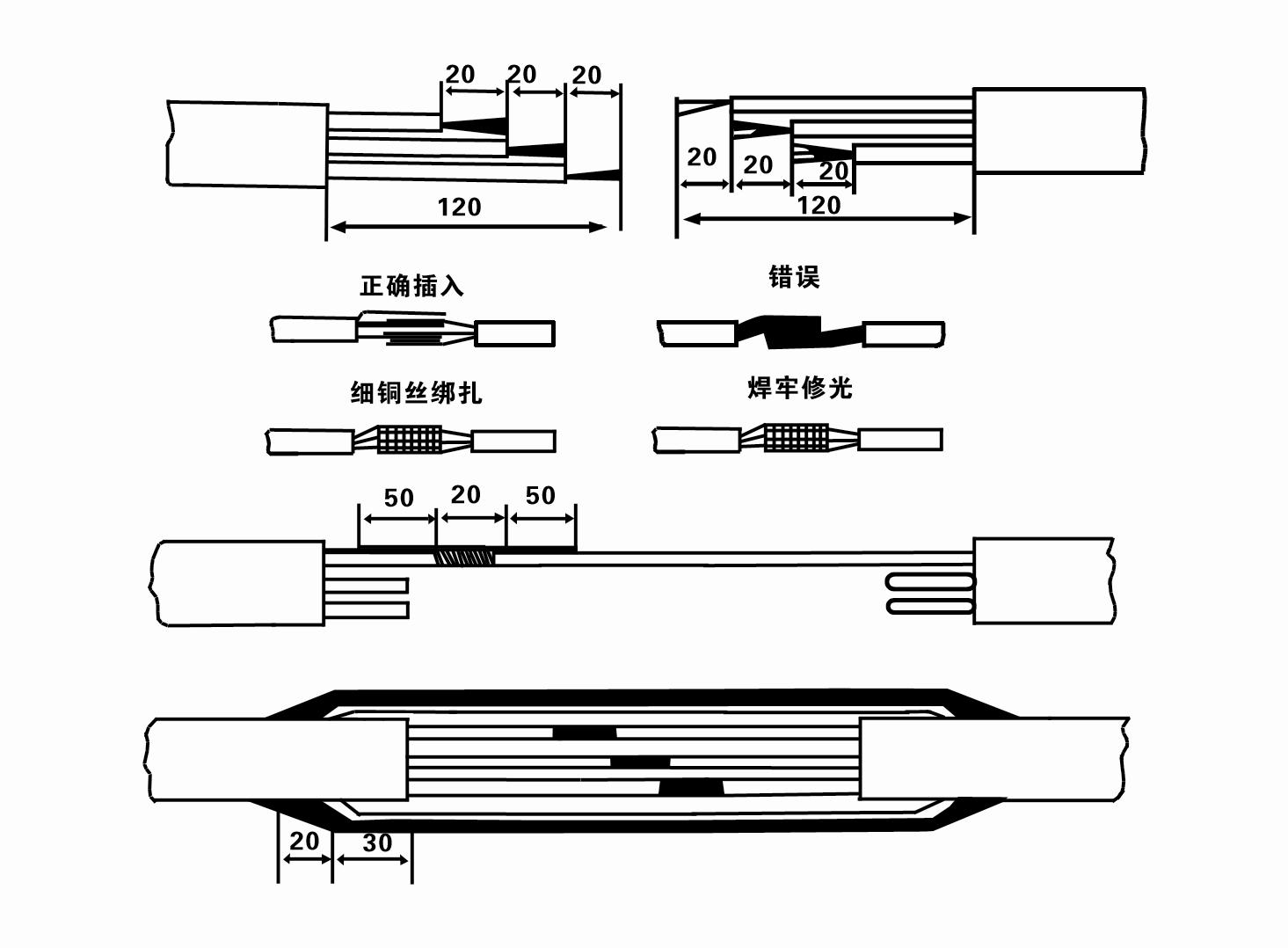
8. Use un multímetro para comprobar se os cables trifásicos están conectados e se a resistencia de CC está aproximadamente equilibrada.
9. Comprobe se o circuíto e a capacidade do transformador están sobrecargados e, a continuación, conecte o interruptor de protección contra sobrecarga ou o equipo de arranque. Consulte a Táboa 2 para coñecer modelos específicos e, a continuación, verte un balde de auga na bomba de auga desde a saída da bomba de auga para lubricar os rodamentos de goma da bomba e, a continuación, coloque a bomba eléctrica sumerxible en posición vertical e firme. Arranque (non máis dun segundo) e verifique se a dirección de dirección é coherente co sinal de dirección. Se non, intercambia dous conectores calquera do cable trifásico. Despois instala o filtro e prepárate para baixar polo pozo. Se se usa en ocasións especiais (como gabias, gabias, ríos, estanques, estanques, etc.), a bomba eléctrica debe estar conectada a terra de forma fiable.
(2) Equipos e ferramentas de instalación:
1. Un par de cadeas de elevación de máis de dúas toneladas.
2. Un trípode cunha altura vertical non inferior a catro metros.
3. Dúas cordas colgantes (cables de arame) que poden soportar un peso superior a unha tonelada (poden soportar o peso dun conxunto completo de bombas de auga).
4. Instale dous pares de abrazaderas (férulas).
5. Chaves inglesas, martelos, desaparafusadores, ferramentas e instrumentos eléctricos, etc.
(3) Instalación de bombas eléctricas:
1. O diagrama de instalación da bomba eléctrica sumerxible móstrase na Figura 2. As dimensións específicas da instalación móstranse na Táboa 3 "Lista de dimensións de instalación da bomba eléctrica sumerxible".
2. As bombas eléctricas sumerxibles cunha cabeza inferior a 30 metros pódense izar directamente ao pozo mediante mangueiras e cables de arame ou outras cordas de cánabo que poidan soportar todo o peso de toda a máquina, tubos de auga e auga nos tubos.
3. As bombas cunha cabeza de máis de 30 metros utilizan tubos de aceiro, e a secuencia de instalación é a seguinte:
①Usa unha abrazadeira para suxeitar o extremo superior da parte da bomba de auga (o motor e a bomba de auga están conectados neste momento), levántaa cunha cadea colgante e átea lentamente ao pozo ata que coloque a abrazadeira na cabeza do pozo e retire o cadea colgante.
② Use outro par de abrazaderas para suxeitar un tubo, levántao cunha cadea colgante a 15 cm de distancia da brida e báixao lentamente. Entre a brida do tubo e a brida da bomba Coloque a almofada de goma no seu lugar e aperte o tubo e bombee uniformemente con parafusos, porcas e arandelas de resorte.
③ Levante lixeiramente a bomba sumerxible, retire a abrazadeira do extremo superior da bomba de auga, ate o cable firmemente á tubería de auga cunha cinta de plástico e áteo lentamente ata que a abrazadeira estea colocada na cabeza do pozo.
④Usa o mesmo método para amarrar todos os tubos de auga ao pozo.
⑤ Despois de conectar o cable de saída ao interruptor de control, conéctase á fonte de alimentación trifásica.
(4) Cousas a ter en conta durante a instalación:
1. Se se atopa un fenómeno de atasco durante o proceso de bombeo, xire ou tire da tubaxe de auga para superar o punto de atasco. Se varias medidas aínda non funcionan, non forzar a bomba abaixo para evitar danos á bomba eléctrica sumerxible e ao pozo.
2. Durante a instalación, debe colocarse unha almofada de goma na brida de cada tubo e apertar uniformemente.
3. Cando se baixa a bomba de auga no pozo, debe colocarse no medio do tubo do pozo para evitar que a bomba funcione contra a parede do pozo durante moito tempo, provocando que a bomba vibre e que o motor varrer e queimar. .
4. Determine a profundidade da bomba de auga ata o fondo do pozo segundo as condicións de area e limo fluídos do pozo. Non enterre a bomba na lama. A distancia desde a bomba de auga ata o fondo do pozo xeralmente non é inferior a 3 metros (ver Figura 2).
5. A profundidade de entrada de auga da bomba de auga non debe ser inferior a 1-1,5 metros desde o nivel dinámico da auga ata o nó de entrada de auga (ver Figura 2). En caso contrario, os rodamentos da bomba de auga poden danar facilmente.
6. A elevación da bomba de auga non pode ser demasiado baixa. En caso contrario, é necesario instalar unha válvula de compuerta na canalización de auga da cabeza do pozo para controlar o fluxo da bomba no punto de fluxo nominal para evitar que o motor se sobrecargue e se queime debido a grandes caudais.
7. Cando a bomba de auga está funcionando, a saída de auga debe ser continua e uniforme, a corrente debe ser estable (en condicións de traballo nominales, xeralmente non máis do 10% da corrente nominal), e non debe haber vibracións ou ruídos. Se hai algunha anormalidade, a máquina debe pararse para descubrir a causa e eliminala.
8. Ao instalar, preste atención á configuración do cable de posta a terra do motor (consulte a Figura 2). Cando o tubo de auga é un tubo de aceiro, lévao desde a abrazadeira da cabeza do pozo; cando o tubo de auga é un tubo de plástico, lévao desde a marca de conexión a terra da bomba eléctrica.
After installation of the underwater pump, it is necessary to recheck the insulation resistance and three-phase continuity of the switch, and check whether the connection between the instrument and the starting equipment is wrong. If there is no problem, you can start the test machine. After starting, observe whether the indication reading of each instrument is correct. If the rated voltage and current specified on the nameplate are exceeded, observe whether the pump has any noise or vibration. If everything is normal, it can be put into operation. Four hours after the first operation of the pump, it should be turned off and the thermal insulation resistance of the motor should be quickly tested, and its value should not be less than 0.5 megaohm. After stopping the pump, it should be restarted after an interval of five minutes to prevent the water column in the pipeline from completely reversing, resulting in the motor burning due to excessive current. After the pump is put into normal operation, in order to prolong its service life, it is necessary to check regularly whether the supply voltage, working current and insulation resistance are normal. If the following conditions are found, the machine should be stopped immediately to eliminate the fault:
1 the current exceeds 20% under the rated working condition.
2 the dynamic water level drops to the inlet section, resulting in intermittent drainage.
3 the underwater pump vibrates violently or emits huge noise.
4 the supply voltage is lower than 340 volts.
5 a fuse is burned.
6 the water pipe is damaged.
7 the thermal insulation resistance of the motor to the ground is less than 0.5 megaohm.
When disassembling the device, it is necessary to untie the cable bundle and remove the pipeline part and the line protection plate. Remove the drain bolt and exclude all water in the motor chamber. Remove the filter element and loosen the screw on the coupling fixed to the motor shaft. Unscrew the bolt connecting the water inlet section and the motor, and separate the pump and the motor (pay attention to placing the device horizontally when separating to prevent the bending of the pump shaft). The sequence of disassembling the pump is as follows: (see Figure 1) water inlet section, impeller, water inlet shell, impeller. Check the valve body, and use a special tool to loosen the cone sleeve fixed to the impeller when removing the impeller. In the process of disassembly, avoid bending the pump shaft and damaging various components. The disassembly process of the motor is as follows: (see Figure 1) put the motor on the platform, and remove the nuts on the screw (pull rod bolt), base, shaft head lock nut, thrust plate, key and lower guide rail - bearing seat, bolt, and then remove the rotor (be careful not to damage the wiring harness), and finally remove the connecting parts and upper guide bearing seat. Unit assembly: before assembly, the rust and dirt of each component should be cleaned, and the sealant should be coated on each mating surface and fastener, and then assembled in the opposite order of disassembly (the movement of the motor shaft after assembly is about one millimeter), after the assembly is completed, the coupling should be flexibly rotated, and then the filter element should be placed for testing. Each time the underwater electric pump has been used for one year, or less than one year but has been immersed for two years, it must be disassembled and inspected in accordance with Article 5 and replace the worn parts.
1, apague a auga na cavidade do motor (especialmente no inverno para evitar que o motor se conxele) e amarre ben o cable.
2, store in an indoor room without corrosive substances and gases, with a temperature below 40 °C.
3, o uso a longo prazo debe prestar atención á prevención da ferruxe das bombas sumerxibles.
- Impulsor
- Manga do eixe
- Funda de eixe de goma
-
Anel de selado
01 Toma de auga de pozo profundo
02 Subministro de auga en rañaceos
03 abastecemento de auga de montaña
04 torre de auga
05 Rego agrícola
06 rego do xardín
07 captación de auga do río
08 auga doméstica

